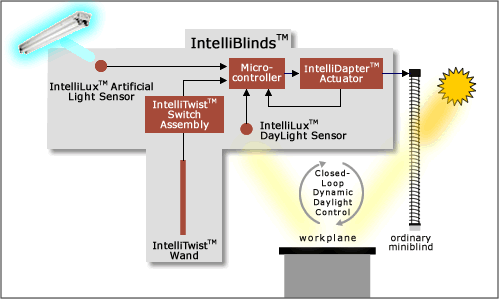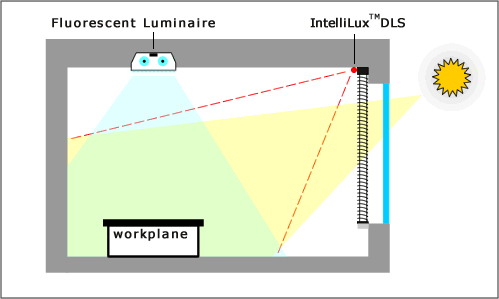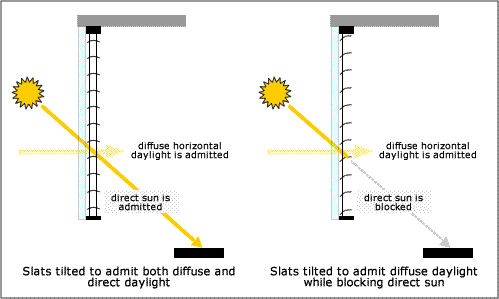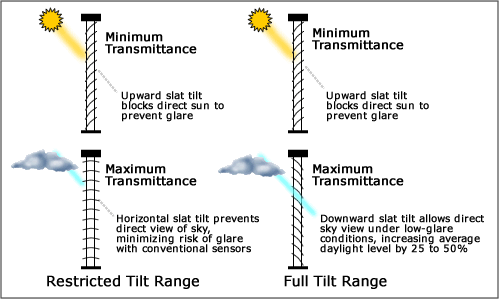Dynamic Daylight Control with IntelliBlinds™
- Automatically Compensates for Changing Conditions
- Provides Closed-Loop Control
- Responds Only to Natural Illumination
- Regulates Glare, Not Illuminance
- Blocks Direct Sunlight While Admitting Diffuse Daylight
- Fully Exploits Available Daylight
- Dramatically Increases Useful Natural Illumination
- Summary of Key Points
Automatically Compensates for Changing Conditions
Despite its simplicity and low cost, the IntelliBlinds™ Model D can do something that only the most sophisticated conventional computerized shading systems can do: it can automatically maintain the optimum shading under changing conditions. Besides providing a healthier and more appealing visual environment, this kind of Dynamic Daylight Control (DDC) is essential for effective daylighting in buildings equipped with ordinary eye-level view windows—and such buildings account for the bulk of the non-residential floor area in the U.S.
View windows must be shaded to avoid occcasional glare. But ordinary manually adjustable shades are typically set to block glare under worst-case conditions, and then simply left alone. So view windows are over-shaded most of the time, drastically reducing the savings achievable through daylighting. The IntelliBlinds™ Model D recovers the lost savings by ensuring that windows are shaded only when—and as much as—necessary to block glare.
For example, the following animation shows a time-lapse (representing about 6 hours) of sky views through three west-facing windows in the metro-DC area: an unshaded window, a window shaded with a manually operated blind, and a window shaded with an IntelliBlinds™-equipped blind.
The unshaded window admits intolerable glare over the time-lapse interval—first from bright clouds and later from the solar disc.
The window with the manually operated blind has the opposite problem. The slats are tilted to ensure that no direct sunlight enters the room at any time over the entire time-lapse interval. But that fixed +20 degree tilt causes the window to be over-shaded most of the time, drastically reducing the average level of useful daylight.
However, by making just four automatic adjustments, the IntelliBlinds™ Model D ensures near-optimal shading over the entire time-lapse interval:
- Beginning with near-minimum shading (at a slat tilt of -22.5 degrees) for a mostly blue sky, IntelliBlinds™ slightly closes the blinds (to -10 degrees) at about 1:40 pm, when a bright cloud moves into the window's field of view.
- IntelliBlinds™ closes the blind still further (to 0 degrees) at about 4:30, when the solar disc has descended low enough on the horizon for direct sunlight to just begin to penetrate the blind.
- The shading is increased again (to +20 degrees) at about 5:30, when direct sunlight from the descending solar disc again begins to penetrate the blind.
- Finally, when the risk of glare has abated at about 6:45, IntelliBlinds™ reduces the slat tilt to 2.5 degrees, allowing a view of the horizon.
Thus, the IntelliBlinds™ Model D dramatically increases the average daylight level relative to the manually operated blind—with no risk of excessive brightness or glare.
- An animation was used instead of video footage in order to show the three cases (unshaded window, ordinary blind, and IntelliBlinds™) side-by-side under identical sky conditions, which would have been difficult with actual video.
- The animation accurately depicts how the IntelliBlinds™ Model D operates, with one exception: view windows are seen mostly from a horizontal perspective, but the animation uses a wide-angled upward-looking perspective to provide a better view of the sky. Due to this exaggerated upward perspective, the slat tilt angles used in the animation are about 10–30 degrees lower than they would be in actual DDC operation. For example, in practice, IntelliBlinds™ would typically use a minimum-shading setting of near zero degrees (instead of the -22.5 degrees used in the animation) to provide the best trade-off between outward view and natural illumination. See Chart 5 elsewhere on this page for an example of slat tilt anges in actual IntelliBlinds™ DDC operation.
- The animation is also accurate in its depiction of how windows with ordinary blinds are chronically over-shaded. See The Need for Dynamic Daylight Control for an extensive discussion of this problem, and why DDC is necessary for effective daylighting in buildings sidelit with ordinary eye-level view windows.
Provides Closed-Loop Control
Obviously, DDC isn't needed in unoccupied rooms, or when there isn't enough daylight to make daylighting worthwhile. the IntelliBlinds™ Model D is smart enough to perform DDC only when it's needed.
When DDC is needed, IntelliBlinds™ uses its built-in, patented IntelliLux™ DayLight Sensor (DLS) to constantly monitor the actual daylight level in the daylit zone, and compares it to a daylight set-point stored in its memory. Whenever the actual daylight level differs significantly from the set-point, IntelliBlinds™ adjusts the blind to minimize the difference. The result is closed-loop control of the admitted daylight:

The user can adjust the daylight set-point at any time by simply twisting the patented IntelliTwist™ Wand. Twisting the wand adjusts the shading; after each adjustment, IntelliBlinds™ updates the daylight set-point to the new daylight level.
Closed-loop daylight control, per se, isn't new. However, the IntelliLux™ DLS sensor is new, and it—coupled with an innovative control algorithm—makes the IntelliBlinds™ Model D the most cost-effective DDC system ever developed.
Responds Only to Natural Illumination
Rather than sensing the visible portion of the spectrum, IntelliLux™ DLS responds only to near-InfraRed (IR) wavelengths. Daylight contains plenty of near-IR, but the light produced by high-efficiency illumination systems doesn't.
So the IntelliLux™ DLS responds only to natural illumination--and that enables it to monitor the entire daylit area without being confused by changing artificial light levels due to dimming or switching of the lighting system:

Regulates Glare, Not Illuminance
As long as direct sunlight doesn't penetrate a daylit space, the occupants will comfortably tolerate a relatively wide range of daylight brightness, especially if the window provides an appealing view. One thing they won't tolerate, however, is excessively frequent (and annoying) shading adjustments.
So, the IntelliBlinds™ Model D doesn't attempt to tightly regulate the daylight level, e.g. in terms of workplane illuminance. Rather, it keeps the shading as open as possible without risking glare. That enables it to meet the two most critical requirements for effective DDC: maximizing the energy savings while minimizing the risk of occupant annoyance.
Conventional DDC systems can't do that, because glare is notoriously hard to sense or estimate using conventional methods. What makes it possible with IntelliBlinds™ is the IntelliLux™ DLS sensor. While the output of the DLS does depend on the daylight illuminance over the daylit area, it's even more highly correlated with perceived glare. In particular, its near-IR spectral response makes it far more sensitive to direct sunlight and the illumination from bright clouds than to diffuse daylight.
Thus, the IntelliBlinds™ Model D actually performs closed-loop glare regulation, rather than closed-loop illuminance regulation. For example, the output of the DLS will spike upward if there's even a small patch of direct sunlight anywhere in its field of view, causing IntelliBlinds™ to adjust the blind until the patch is eliminated.
When coupled with the broad field-of-view enabled by the DLS' immunity to artificial light, this enables IntelliBlinds™ to ensure that the entire daylit area is free from glare-inducing conditions.
And the fact that IntelliBlinds™ responds to glare at the edges of the daylit space gives it another huge advantage: it will typically begin increasing the shading before the glare reaches the center of the daylit zone, where occupants are most likely to be seated. So, occupants are never exposed to glare--not even for the few moments required for IntelliBlinds™ to complete a shading adjustment.
Blocks Direct Sunlight While Admitting Diffuse Daylight
Its closed-loop glare-blocking capability also enables IntelliBlinds™ to fully exploit a unique advantage of Venetian blinds: despite being among the least expensive types of window covering available, Venetian blinds can be adjusted to block direct sun while still admitting diffuse daylight. In contrast, other types of window covering must be fully closed to control glare in the presence of direct sun, particularly at low solar elevation angles.

Venetian blinds' ability to admit diffuse daylight while blocking direct sun can significantly increase the energy savings achievable through DDC.
However, there's no reliable conventional method of sensing direct sun within a daylit space. So the only way for conventional DDC systems to take advantage of this capability is via open-loop control: the slat tilt is adjusted in a way that is calculated (as a function of the prevailing solar elevation) to block direct sun.
However, to account for errors, the slats must be closed a little further than the calculated critical tilt angle, which reduces useful daylight. And the need for a slat-tilt sensor and solar elevation information substantially increases system cost and complexity.
Those aren't issues for IntelliBlinds™: its closed-loop DDC function automatically tilts the slats of the host blind only enough to block direct sun—with no need for solar position or tilt angle information.
Fully Exploits Available Daylight
Direct sun isn't the only potential source of glare; bright clouds and sunlight reflected from nearby glass facades can also cause uncomfortable visual conditions.
In a blind-based DDC system based on conventional technology, the only practical way to mitigate this risk is to ensure that the slats are never tilted to permit a direct view of the sky. Unfortunately, this also reduces the energy savings under low-glare conditions, such as on heavily overcast days or cloudless days without direct sun.
On the other hand, because IntelliBlinds™ directly senses and responds to incipient glare, it can exploit the full slat-tilt range of the host blind:

This enables IntelliBlinds™ to exploit nearly all the available daylight under low-glare conditions—increasing average savings by about one-third relative to conventional blind-based DDC systems.
Dramatically Increases Useful Natural Illumination
When compared to a manually operated blind, the DDC capability provided by IntelliBlinds™ dramatically increases the average level of glare-free natural illumination.
That's exemplified by the following chart, which shows the measured horizontal daylight illuminance at desk height in a typical sidelit area over the course of a mostly sunny workday:

The data of Chart 5 were collected in a private office with a west-facing window in the metro-DC area, just a few days after the winter solstice. This window receives direct sun in the late afternoon on days without heavy clouds, requiring that the blind be fully lowered with a slat tilt angle of at least +40 degrees to keep the sidelit area glare-free.
Due to shading from nearby buildings, this high-glare condition occurs for only about 30 minutes on December days. Yet, prior to installation of IntelliBlinds™, the occupant of this office had kept the same fixed blind setting for at least a week, even on days with heavy clouds.
And that's typical of manually operated shading in sidelit areas: even though people prefer daylight to artificial light, they're not willing to adjust window shading throughout the day. As a result, manually operated window coverings are typically adjusted to block glare under worst-case conditions, and then simply left alone—greatly reducing the average level of useful natural illumination.
But with the IntelliBlinds™ Model D, there's no risk of glare or excessive solar heating, so users almost always choose a daylight set-point that results in a far higher average daylight level than with manually adjusted shades.
And that was the case with the data of Chart 5: the user-selected setpoint caused IntelliBlinds™ to keep the slats open for most of the day, closing them only when (and only as much as) necessary to block glare—not just from direct sun, but from bright clouds, too.
As Chart 5 shows, the result on that particular day was a dramatic increase in useful daylight. The near-zone daylight illuminance at desk level averaged about 280 lux with DDC, versus just 40 lux without DDC—an increase of 600%.
- The left y-axis of Chart 5 plots the horizontal WorkPlane Illuminance (WPI) measured with a conventional desk-height WPI sensor positioned 0.8 window-head-heights inward from the window. The lights were kept off during the data collection, so that the measured WPI was due solely to daylight.
- The right y-axis represents the slat-tilt angle of the Venetian blind shading the window, with positive tilt angles allowing a ground view and negative tilt angles allowing a sky view. The tilt was measured using a slat-mounted tilt sensor.
- The base-case slat tilt angle (i.e. the tilt angle used for each without-DDC sample point) was the actual occupant-adjusted setting of the blind on the days prior to the data collection. The blind had been left at that setting for at least a week.
- The daylight set-point used for IntelliBlinds™ was the actual occupant-selected set-point, which remained constant for the period over which the Chart 5 data were collected.
- To ensure that the with-DDC and without-DDC data were collected under identical conditions, the following procedure was used to obtain each temporal sample:
- The slat tilt angle chosen by IntelliBlinds™ and the resulting daylight WPI were recorded.
- Then, the data collection system commanded IntelliBlinds™ to to suspend DDC operation and tilt its slats to the base-case (mostly closed) slat tilt angle, and the daylight WPI was again recorded.
- Finally, the data collection system commanded IntelliBlinds™ to return to the original (DDC-selected) slat tilt angle and re-engage DDC operation.
Of course, the 600% increase in average daylight WPI shown in Chart 5 is specific to the conditions under which the data were collected, and is a function of numerous installation-dependent and time-dependent variables (especially the base-case slat tilt angle). Taking these variables into account, the median increase across the entire stock of U.S. office buildings will be 200%, i.e. IntelliBlinds™ will typically triple the level of useful, glare-free natural illumination.
Summary of Key Points
- The IntelliBlinds™ Model D provides closed-loop Dynamic Daylight Control (DDC), adjusting its host blind in response to the output of the patented IntelliLux™ DayLight Sensor (DLS)
- Unlike conventional illumination sensors, the IntelliLux™ DLS responds only to natural illumination and is far more sensitive to glare-inducing conditions
- That enables IntelliBlinds™ to sense and block incipient glare much more effectively than conventional DDC systems, allowing it to admit more glare-free daylight
- IntelliBlinds™ typically triples the average level of useful natural illumination, dramatically increasing the savings achievable through daylighting

